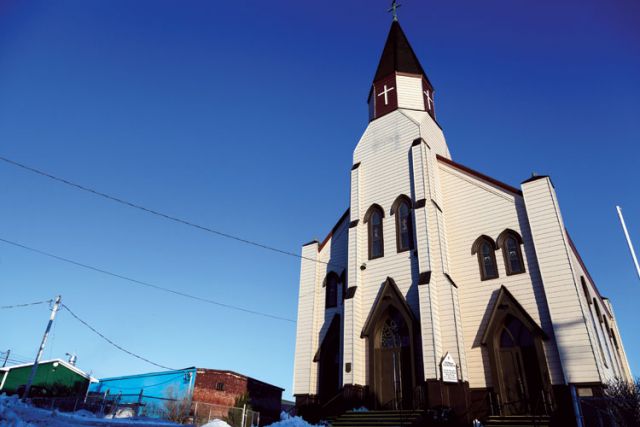For two years now the community has been battling to save St. Mary’s after it was slotted to close by the diocese of Antigonish in July 2012. The closing was delayed as the parish was celebrating its centenary the following year, but diocesan officials have confirmed plans have not changed.
“We discovered that the 100th anniversary was last year in 2013 and so as a result we said we’d allow the church to remain open and then we will discuss what will happen to that church after that,” said Antigonish Bishop Brian Dunn. “We’ve decided that the parish would remain open for the time being.” But Dunn said its eventual closure is inevitable.
Parishioners, however, are not giving up and have undertaken several initiatives since 2012 to show the importance of the parish to the community. These efforts included a pilgrimage to the cathedral in Antigonish, several community social events and a 2013 centenary celebration concert with the Men of the Deeps.
“Although St. Mary’s Polish Church is provincially designated a heritage landmark, and although that is very important to us and to the broader community, St. Mary’s Polish Church is much much more than a building,” said Tom Urbaniaka, chair of the parish’s pastoral council. “It is not an exaggeration to say that without St. Mary’s Polish Church there would be no Polish community in Cape Breton. That is not to say that the church is the cultural centre, although the cultural functions are very important, but it is to say that faith and the culture are inextricably intertwined in so many ways.”
Even without a Polish-speaking priest at the moment, Urbaniaka said the Polish culture remains vibrant in the church, the only Polish parish in Atlantic Canada.
“To someone just visiting it wouldn’t take long for them to be struck by the uniqueness of the place and the community,” he said, noting that the traditional Polish costumes, singing and prayers set the parish apart from Sydney’s other Catholic churches.
Much of the diocese’s pastoral plan since 2007 has focused on addressing the issue of too many churches with not enough parishioners or priests.
“We’re in a bit of a position now to say we’ve got fewer priests and what are we going to do with all of the churches that we have which are not attended by a lot of people,” Dunn said, adding there are only about 60 parishioners at St. Mary’s. “We need to close a couple of the larger churches and three of the smaller churches and one of the small churches was the Polish parish.”
Dunn said this situation is playing out across his diocese.
“The steel plant closed (and) the coal mines closed so a lot of people moved out of here, especially the young people,” he said. “Secondly, in terms of our own church issue, in the 1960s our diocese had 250 priests and today we have 41 priests.”
In the neighbouring town of New Waterford this reality has already reduced the number of active parishes from six to one.
“The goal of all of this is to try to create a number of parishes that will be able to be vibrant parishes and that serve the faith of the people who are left here,” said Dunn.
Stephanie Melnick Black’s grandfather helped open St. Mary’s in 1913.
“When the parish was first thought of being built he was one of the ones at the meeting,” said the principal of Harbourside Elementary School in Sydney. “While he was working at the steel plant his 12-hour day shift, he would go in the evenings with his pick and shovel, and a horse if they were able to gather one from one of the farmers up on the hill, and they literally excavated the basement by working at night.”
This started a legacy of parish activity in the Melnick family which continues to this day.
“I know how hard my grandparents worked to get it developed, how my mother worked so hard and my dad and I owe it to them to keep our heritage alive,” she said.
When the late Pope John Paul II visited Nova Scotia in 1984 he reinforced the cultural importance of preserving the parish.
“He met with our parish at the airport in Halifax,” recalled Melnick Black. “One of the things he did say is I know about your parish here in Nova Scotia, your little church in Sydney, and whatever you do you make sure that you always continue to honour your forefathers by keeping your parish alive and keeping your customs and traditions alive.”
Dunn said the diocese is willing to work with the Polish community to keep its culture alive in Sydney.
“There may be some things that we can do to provide some holy services there once in a while, weekday services, but as a full- fledged parish we can’t continue on,” he said.
Dunn said an alternative would be to hold a Polish Mass at neighbouring Holy Redeemer when the inevitable comes for St. Mary’s.
But that isn’t good enough for Melnick Black.
“We will fight it until the end because that is the only thing that we have,” she said. “I’d hate to see it go and I don’t intend on seeing it go. If it is to close I will be the last one hanging on the door.”


